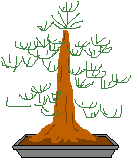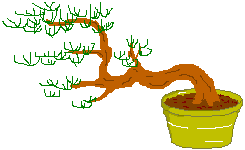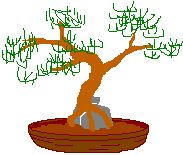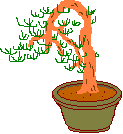



Chokkan
Kengai
Ishizuki
Bunjingi
(Bonsai)
Bonsai is a potted tree or plant dwarfed by artificial methods of culture and grown into desired and artistic shape. Bonsai dates back to the Heian Period (the 8th to 12th century), but it became widely popular in the late Edo period (the 18th to 19th century).
Many kinds of tress can be made into bonsai: various evergreens and deciduous trees, and trees that blossom and bear fruit. The pine, plum and azalea are particularly common.
The bonsai begins with a normal seedling or seed. The art of bonsai makes use of the close relationship between a tree's roots and its size. If you keep the roots small, the tree will be small. It takes a lot of skill and experience. You need to select appropriate type of soil, use fertilizer, periodically report, wire the branches or trunk to control the shape, and prune.
The worth of bonsai is based on its form and its age. Bonsai is expected to appeal to the viewer's imagination by its natural beauty. With proper treatment a bonsai plant can last for decades or even centuries.
As you see from bonsai, the Japanese have long been skillful at making small finely crafted things. There is a close relationship between this trait and the quality of today's Japanese technology products.
Bonsai is popular even in some foreign countries. However, it is ,by mistake, often called "banzai"(which literally means "cheers" in Japanese).
The typical tree shapes of bonsai are:
Chokkan (an upright tree)
Kengai (a tree which appears to be hanging from a cliff toward a gorge)
Ishizuki (a tree whose roots cling to rocks)
Bunjingi (a graceful curved shape).
 |
 |
 |
 |
Chokkan |
Kengai |
Ishizuki |
Bunjingi |